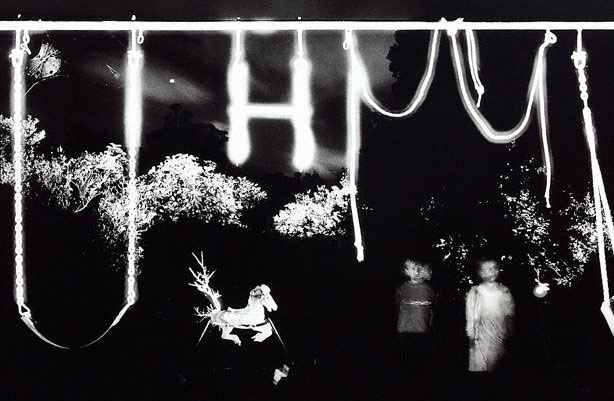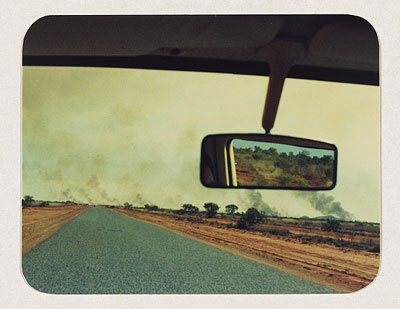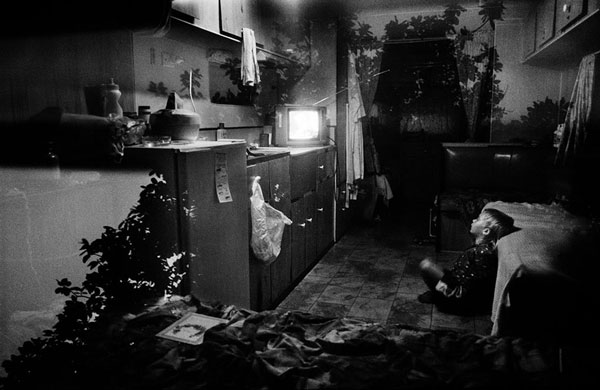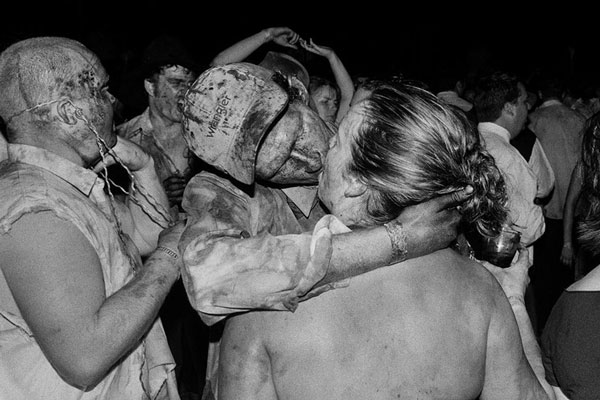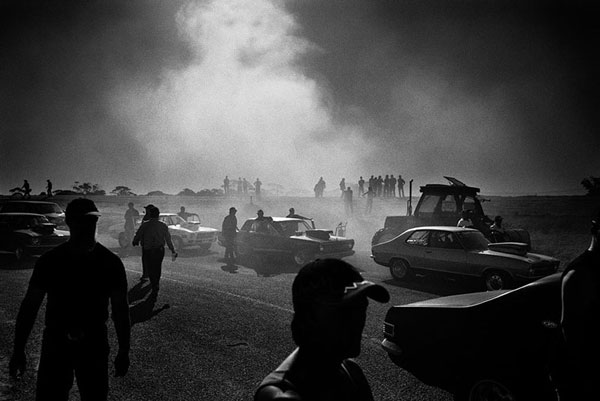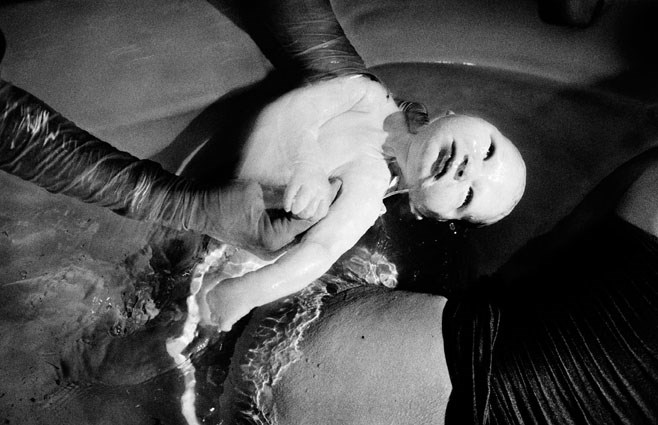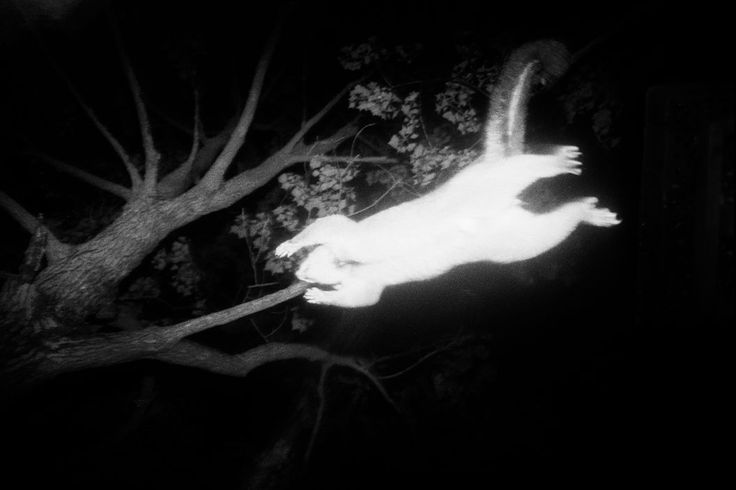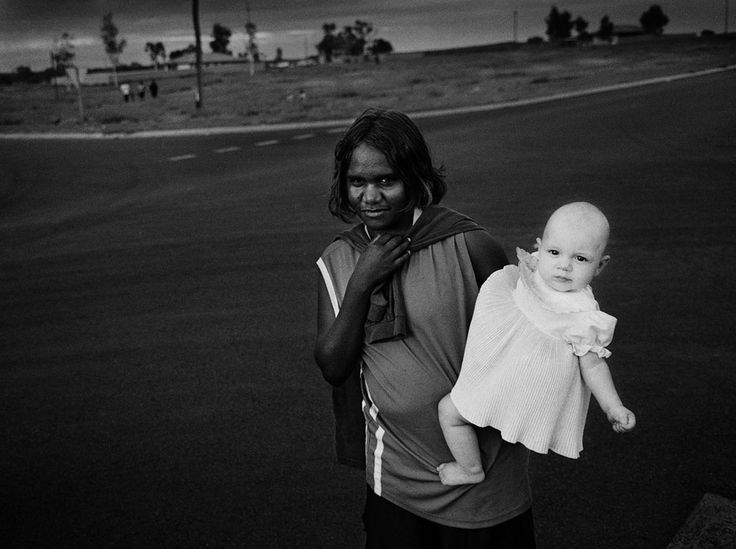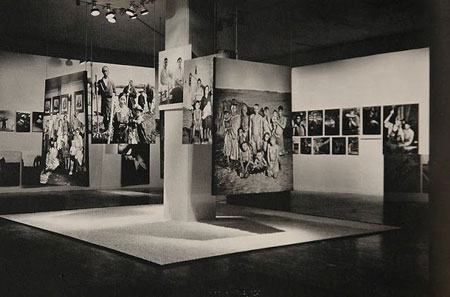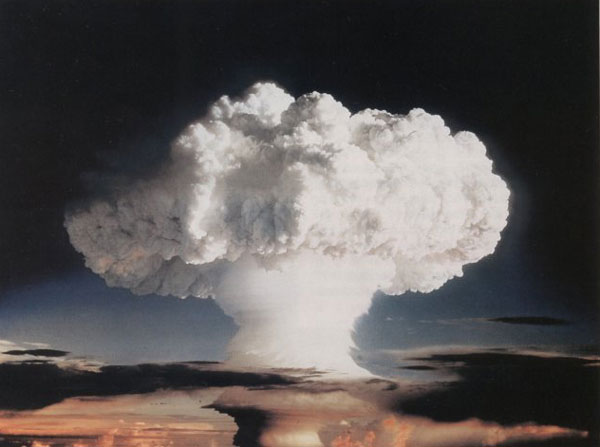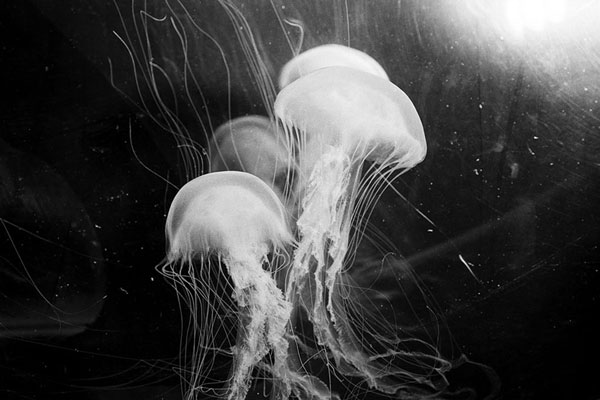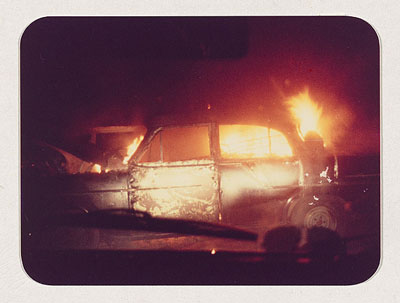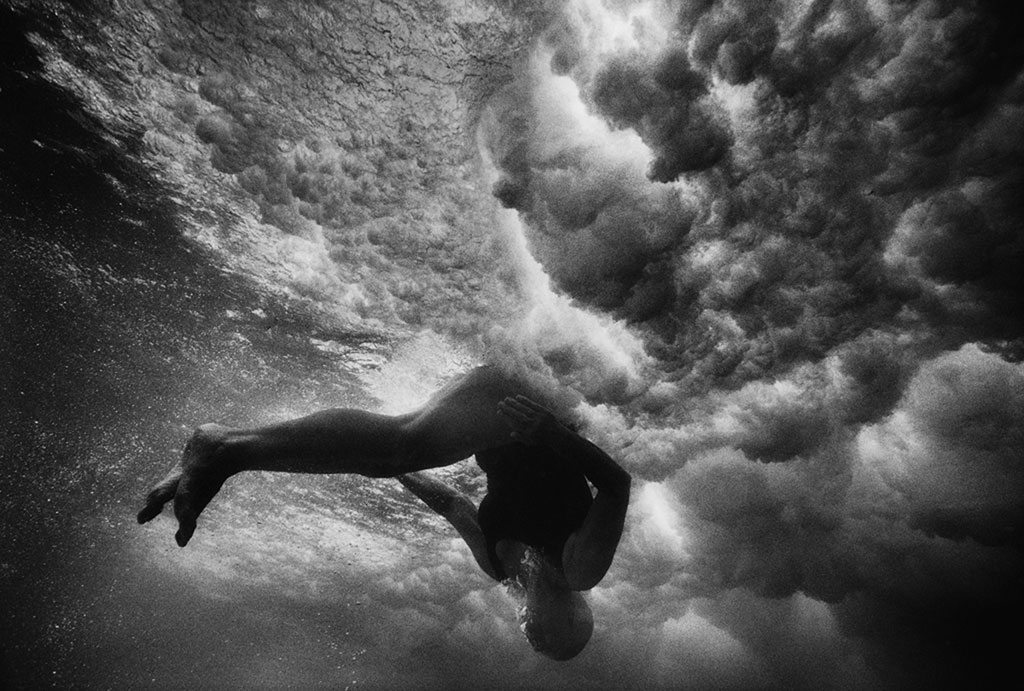|
|
Home-Page / Introduction / Chapter 1 / Chapter 2 / Chapter 3 / Conclusion / List of Images / Bibliography
Chapter ThreeThe Road in Australian Photography with a focus on Minutes to Midnight by Trent Parke
As already demonstrated Wesley Stacey established a tradition of road photography in Australia in the 1970s with the series The Road. The work was well received and has even been credited with expanding the collective vision of contemporary photography in the 1970s.183 This chapter will consider another substantial Australian road photography work, Minutes to Midnight (2003)184 by Trent Parke. The series will be examined in relation to Wesley Stacey's The Road to ascertain whether there is a continuing tradition or if it is forging a new direction of the road in Australian photography. The real and imagined influence of American photography in Minutes to Midnight will be uncovered through comparisons to the road photography of Robert Frank's The Americans, as well as tracing links to the landmark 1950s exhibition The Family of Man.185 Finally, in considering alternate subject matter, the gradual acceptance of photography as a fine art in Australia as well as the issue of the neglected artist and its attendant repercussions, this chapter will question the nature of the tradition of road photography in Australia. Trent Parke's two-year 90,000km road trip around Australia manifested in the portfolio Minutes to Midnight and was the first sustained road photography project since Wesley Stacey's The Road. After reading about a survey that claimed that over half the population believed that Australia had come to the end of an era and had lost its innocence, Parke was disturbed and felt it was the right time to find out for himself "what Australia was.186 The result was a suite consisting of thirty black and white photographs depicting a deeply felt, provocative and multi-layered examination of contemporary Australian society. What Parke found was "not only a dead heart, but a heart of darkness. He found a harsh country still dealing with its brutal colonial past, unsure of its future and where it is going."187 Parke's signature style of a 'contrasty' quality in tandem with a grainy, gritty, dreamy print resolution188 (Fig. 49) augments the sense of unease and otherworldliness present in the portfolio and distinguishes it from Stacey's trailblazing series.
Discovering Australia: within and withoutIn many ways, Stacey's The Road appears to be quite a different entity to Parke's Minutes to Midnight in intention, technique and style. Stacey was focused on the 'driving experience' and 'evoking the spirit of the road' whereas Parke wanted to discover Australia, specifically "the current and changing state of the Australian nation...to document its people and culture to attempt to capture the mood and emotions of a still young and emerging nation before it is significantly changed forever."189 The photographic road trip was a means to achieve that aim. Stacey utilised cheap technology, the Kodak Instamatic to achieve his goal and his use of colour photography was a stylistic choice somewhat unconventional for the time. Colour became gradually adopted by 'serious' photographers in the 1970s and 1980s and the use of black and white today distinguishes itself also as a conscious stylistic decision.190 Parke favoured a classic Leica camera and Kodak Tri-ex film developed with a specific Agfa chemical that heightens contrast. The repeated road imagery in Stacey's series also marks it apart from Parke's portfolio which features the actual road sparingly (Fig. 50). Overall the two series present different visions and experiences of travelling around Australia that are only tenuously connected through depictions of the land and people. The depiction of the land in The Road and Minutes to Midnight reflect the varying relationship the two photographers have with the land. Stacey presents Australia with an openness and general embracing of the land with only the occasional hint of the danger that lurks. His image of smoke far off on the horizon (Fig. 51) is a subtle allusion to the potential result Parke shows with devastating effect in Firestorm, Canberra (Fig. 52).
The overarching sense of the land in Minutes to Midnight is a place dark, mysterious and threatening. Stacey has lived in the bush since the 1970s and his series reflects his comfortable attitude and interaction with the land.191 Newcastle-born Parke's imagery on the other hand never loses the sense of a city boy's excursion into an unfamiliar land. The attention paid to the exterior rather than the interior is a common link between the road photography of Stacey and Parke. This commonality is also present in their depiction of people. As Stacey's modus operandi was to shoot from the car, his imagery is limited to what is visible from the driver's seat. Yet Parke, who leaves his vehicle, does not often venture inside domestic or commercial interiors. Only one image in Minutes to Midnight is of an interior, that of a boy watching television inside a caravan (Fig. 53). The interiority, or individual nature, of people within the images is also held at a distance. Sandy Edwards notes that there is no simple identification offered with an individual or group within the frame of Parke's images.192 People remain unknowable and in some cases literally faceless (Fig. 54). They perform as generalisations and archetypes and reflect the often unequal power relationship between photographer and subject.193 It is the photographer who has the choice of how to depict his subjects. In The Road, apart from the minority of people in the photographs, there is also a distinct lack of individuality when they do appear.194 The relative absence of characterisation of people in Minutes to Midnight differentiates Parke's series from the American tradition which was often concerned with the plight and personality of individuals (fig 2, 5, 13).
Left-hand Drive: the American influence in Minutes to MidnightDespite links between The Road and Parke's series, Minutes to Midnight marked a distinct return to road photography in the American tradition. The American road photographers' pursuit of the journey that fulfilled the desire to depict or capture a society in photographs has parallels in Parke's desire to discover Australia for himself. Many critics have acknowledged the debt of Parke's series to Robert Frank's photographic trip across America which resulted in The Americans.195 Parke set out to document "the current and changing state of the Australian nation."196 Frank's object with The Americans was 'the visual study of a civilisation,' but what he did portray was in actual fact, the current and changing state of America. The images depicted "a lethargic, rather depressed and lonely America, sad and tired...with a desperate need for intimacy and companionship"197 combined with simmering racial tensions, economic inequality and consumerism. Similarly, Parke's images reflect an Australia that is not so picturesque.
In the words of Blair French we see a country of: ...drought and of drinkers, of caravan parks on the edges of dirty rivers; a country where masculinity rules, whether imaged in pastimes that involve the killing of wild animals, the hedonistic revving of engines (Fig. 55) and consumption of fossil fuels or the baring of breasts before fist waving crowds of concert goers; a country absorbed in the immediate, everyday business of getting ahead, or perhaps just clinging on, long since closed down to its own fragile, fracturing ecologies of both natural and social order.198 The Doomsday-like title of the portfolio, Minutes to Midnight, emphasises the apocalyptic and not-so-pretty vision of Australia that Parke witnessed. When The year is 2003. The fate of the world's largest island hangs in the balance. As the country thirsts from the worst drought in recent history and firestorms blaze across the land, plagues of feral pigs, cats and cane toads roam the countryside destroying all in their path. In the major cities people live in the shadow of terrorism. Politicians prophesy it is only a matter of time. While the world embraces advancing technology and the global market, many of Australia's Indigenous people have been abandoned to alcohol and substance abuse, poverty and ill health. Escalating insurance premiums have closed down long-running iconic community events. The majority of the population believes the country has reached the end of an era and is fast losing its innocence. The year is now 2005. Nearly two years have passed and 90,000kms of Australia have flown by in a road trip from beach to bush. Minutes to Midnight is that journey. One man's attempt to find his place within an Australia vastly different from the one in which he grew up. This is what he saw...199 The Americans drew criticism for portraying what some believed to be the warped, negative and 'sick' view of America from an outsider. Parke's view also uncovers undercurrents of violence and dysfunctionality beneath the approved nationalistic and tourist-oriented visions of Australia tempered by dreamily atmospheric images (Fig. 49). Yet this vision has been understood to be very much his own view, not what the critics have projected. The belief that photo documentary can often tell us more about the inner world of the photographer than about the external world that it is supposed to document200 is brought to bear in Minutes to Midnight. Parke's agenda of attempting to 'find his place' in Australia resulted in images reflecting the ecological disasters that have befallen the country (Fig. 52), native and introduced animals in full flight (Fig. 56, 57), as well as observations of human behaviour (Fig. 54). But he also included extremely personal images such as the birth of his son (Fig. 58).
At its debut exhibition these intimate works were complemented by informal photographs taken by Parke's partner, Narelle Autio, documenting their journey as well as photographs of their parents' courtships and early domestic lives.201 The melding of the historic and atmospheric is perhaps close to what Daniel Palmer terms 'real fictions' and supports the theory of the waning notion that the camera can record the whole story and there is such a thing as 'photographic truth.202 The documenting of ordinary life by Autio and family pictures juxtaposed with the heightened intensity of Parke's images blurs the distinction between truth and imagination. Robert McFarlane goes even further, believing that the overarching sense he is left with is about Parke's remarkable visual style rather than Parke himself or the people he photographed.203 The intimate nature of Parke's photographic road trip in addition to his distinctive style which at times overwhelms the subject matter separates Minutes to Midnight from Frank's The Americans. The heritage of Robert Frank evident in Minutes to Midnight is not the sole American photographic influence that can be discerned in Parke's series. Parke may not be aware of the landmark 1955 exhibition The Family of Man, but links can be made in both display and content. Influential photographer and Director of Photography at the Museum of Modern Art in New York, Edward Steichen, conceived of the exhibition which sought to act "as a mirror of the universal elements and emotions in the everydayness of life - as a mirror of the essential oneness of mankind throughout the world."204 Two million photographs were sorted through before being reduced to 503 images from 68 countries taken by 273 photographers who were amateurs and professionals, famed and unknown.205 The exhibition opened to great critical and public acclaim, with only a few dissenting voices, both locally and internationally,206 including a visit to Australia in 1959. The scale of The Family of Man was a massive undertaking and its impact was commensurate. Part of the impact of The Family of Man was due to the staging of the exhibition that encouraged a complete engagement. The display mechanics of The Family of Man, designed by Paul Rudolph, was what might now be called an interactive experience.207 The different scaled images placed at different heights and in varying configurations created a new and unusual visitor experience (Fig. 59, 60). The staging of Minutes to Midnight at the ACP was also intended to "completely unsettle conventional expectations of how photography should be presented and absorbed.208
The photographs were displayed in different sizes, framed and unframed, at varying heights upon darkened walls in multiple rooms.209 Halfway through the exhibition an octagonal chamber contained a lightbox facing downward from the ceiling featuring a large abstract picture of flying foxes and on the floor immediately below, another lightbox containing a backlit, grainy image of a whale shark.210 A soundscape of rural night noises was also audible in one of the rooms.211 Parke wished to created "an experience for people - something on the grand scale of epic cinema" which he didn't think could be achieved with "small pictures that are all the same size presented on white walls."212 The staging of Minutes to Midnight can therefore be seen to be descended from The Family of Man in terms of creating a non-passive experience for the viewer that attempts to immerse them in the journey. Minutes to Midnight also shares with The Family of Man content dealing with universal themes. The major themes of The Family of Man were listed as creation, birth, love, work, death, justice, the search for knowledge, relationships, democracy, peace, and opposition to brutality and slaughter.213 Parke foresaw broader themes in his work that related to the wider world, not just remote and regional Australia. The bigger picture encompassed terrorism, racism, poverty, natural disasters and the struggle to survive.214 Some of these elements are also present in the road photography of Evans, Lange and Frank. Parke used this symbolism to "tell a much bigger, epic story of the world through pictures made specifically in Australia."215 One specific image connects Minutes to Midnight to The Family of Man - a nuclear explosion. When the latter was first exhibited in New York, the sole colour photograph in the entire show was a large colour transparency of a nuclear explosion (Fig. 61).216 Parke found symbols organically emerged in his work and discovered that a photograph of a jellyfish became a nuclear explosion217(Fig. 62).
Interestingly, Stacey also chose an apocalyptic final image in The Road, a burning car (Fig. 63). The broader themes contained in the two exhibitions speak not only of the continuing concern of twentieth century humanism but also of the universality found in the language of photography. Parke desired to create a "psychological portrait"218 of Australia with his series Minutes to Midnight. A photographic road trip was an established model that enabled Parke to achieve his aim. While similarities can be drawn between Parke's series and Stacey's The Road, the differences are greater.
The simplicity and straightforwardness, or unpreciousness, of Stacey's work is contrasted wholly with the dramatic presentation of Parke's suite. The exhibiting of both series also compounds this distinction. The commercially processed snapshots of The Road displayed on the white walls of the ACP are worlds away from Parke's immersive exhibition at the same venue. The intensity of the latter was amplified by the overwrought and almost hysterical tone of the introductory wall text. Rather than continuing in the vein of road photography begun by Stacey in Australia, Minutes to Midnight can be considered to be following the tradition of road photography established and developed in America. Stacey engaged with the road specifically as a motif to express the Australian driving experience as well as sustaining a focus on the landscape whereas the continued use of the road in photography in America has been primarily to discover the country through its people. Dead End?: The Nature of the Road Photography Tradition in Australia Despite the significant Australian road photography exemplars The Road and Minutes to Midnight, there has been an absence of a sustained and developed tradition of road photography in Australia. Various factors have contributed to this phenomenon such as alternate favoured subject matter, the low acceptance if photography as a fine art in Australia, and the neglect particular of photographers. It has already been noted that photographic images of expeditions and explorations were non-existent in the first fifty years of photography in Australia.219 As settlement in Australia has been largely centrifugal, cities developed on the rim of the island continent220 and this had a consequence upon exploratory photography. Since the nineteenth century, except in Tasmania, photographers have favoured relatively accessible locations, initially by train and later by car, and close to the main urban centres.221 This has meant that the favoured photographic locations have been the beach and the city. As an island continent it is understandable that the beach has featured extensively in Australian photography. In the introduction to the first major publication on the photographs in the National Gallery of Australia's collection, Australian Photographers: the Philip Morris Collection (1979), James Mollison observed the continued gravitational pull of the beach at the expense of images of the outback and other conventional views of Australia. The beach appeared and reappeared in hundreds of portfolios and Mollison stated that "today, the most constant preoccupation of our photographers is the beach and swimming."222 The beach has a specific association in the Australian consciousness - as a place of freedom, pleasure and relaxation.223 In America, the road more often represented these characteristics. The car enabled personal freedom and the ability to travel around America according to one's own timetable and route224 and the road beheld all sorts of possibilities. The pleasure and relaxation of a drive, particularly on Sundays, which emerged concurrently with the increase of leisure time between the two World Wars has been well articulated by J. B. Jackson.225 The beach in Australia can thus be seen as the equivalent to the road in America. Photographic images of the beach in Australia are iconic in a way that road images have struggled to be. Max Dupain's Sunbaker (1937)226 has been lauded as possibly the most famous and recognisable Australian photograph yet produced.227 The popularity of the 'body culture' movement of the 1930s, of which Dupain was influenced by, found an ideal site in the beach where people frolicked semi-naked in a celebration of physical health and vitality.228 Images of beach culture continued through the decades including a reimagining of the Sunbaker by Anne Zahalka.229 Wesley Stacey did not dwell on the beach as a subject, although beach imagery does appear in his work including The Road (Fig. 44), he was generally more focused upon the interior of Australia. Trent Parke on the other hand, collaborated with Narelle Autio on an entire series centred on the beach. Shot predominantly from beneath the surface of the sea, The Seventh Wave (2000)230 examined the Australian penchant for having fun at the beach (Fig. 64, 65). The preoccupation with the beach is therefore one reason the road has been precluded from becoming as established a motif.
Another favoured photographic subject, more popular than the road, was the city and urban areas. Max Dupain (1911-1992) and David Moore (1927-2003) were part of the first generation of Australian documentary photographers and focused largely on contemporary Sydney life. Dupain's The Meat Queue (1946)231 was taken as part of his work for the federal government's Department of Information's campaign to attract new migrants.232 He travelled extensively for this campaign but Dupain's photographs were in no way concerned with the 'journey'. Moore's Redfern Interior (1949)233 is another example of the affinity with the international social documentary movement exemplified by the FSA photographers234 as well as the concentration on the inner city. For documentary photographers working in the 1970s, such as John Williams (b.1933), Ingeborg Thyssen (1945-2002), Philip Quirk (b.1948) and others, the city streets provided the perfect setting for observing people unnoticed.235 Helen Ennis discovered that during the 1970s documentary photographers found their inspiration in the city rather than the outback and constructed an alternative view of contemporary life.236 Urban development also fascinated photographers in the 1970s, including Stacey, who captured the urban houses and streets of a Sydney cliff-top suburb in his series The Edge (1973).237 That Stacey's series revolves around the border of land and sea as well as the zone between the constructed and natural environment238 proves the notion of the hold the beach/coast has on Australian photographers. The acceptance of photography as a fine art in Australia is a broader context in which the establishment of a tradition of road photography can be positioned. Australia lagged behind America in including photography in art institutions, which was active in photography collection from early twentieth century.239 It wasn't until the 1970s that photography gained currency. The first curatorial department of photography in an Australian art museum was established in 1972 at the National Gallery of Victoria. The Art Gallery of NSW followed two years later by appointing a Curator of Photography and in 1977 the Art Gallery of South Australia began to build a collection of Australian and international photography. Photography galleries were being established such as the Australian Centre for Photography (ACP), co-founded by Wesley Stacey, which opened in 1973. The display of documentary photography became regular in art museums and specialist photography galleries also from the early 1970s.240 Photographic publications such as Photofile appeared in the 1980s, decades later than the founding of Aperture in America in the 1950s. The relatively slow exposure of photography to the Australian public hindered the establishment of genres, such as road photography. The Road was a major work that garnered much praise when it was originally exhibited in 1975; however it did not result in a trend of photographers embarking on their own photographic road trip. It had, in the words of Gael Newton, "no legacy."241 Apart from selected images appearing in exhibitions such as Shades of Light: Photography and Australia 1839-1988 and Photographs of Wesley Stacey in 1991, both at the National Gallery of Australia,242 The Road has not been exhibited in its entirety since 1975. A major contributor to this situation was the unpopularity of landscape photography which increased during the 1980s and 1990s.243 Agents who attempted to represent Stacey found it difficult to get galleries and cultural institutions interested in his work because of the landscape angle.244 As a consequence Stacey's work is not held substantially in collections around the country, with the National Gallery of Australia a notable exception.245 Stacey's personal lifestyle also affected his visibility. In the mid-1970s Stacey moved permanently to the far South coast of New South Wales which would remain his base while he continued to travel around Australia on photographic trips.246 The lack of opportunity to observe The Road in Australian cultural institutions contributed to its invisibility and the lack of attention has also been repeated in publications and critical writing. Apart from brief inclusions in standard photographic texts such Shades of Light and Photography and Australia, published material is lacking. The invisibility of The Road meant that it was not able to have an impact upon and influence later generations of photographers. That it took thirty years before another significant road photography work appeared, Minutes to Midnight, is not surprising considering the lack of attention given to its predecessor. Thus the neglect of Stacey's The Road by cultural institutions and the absence of published material, along with the preference for other subject matter such as the beach and city, are factors in the absence of a sustained and developed tradition of road photography in Australia.
>>>>> next: Conclusion Home-Page / Introduction / Chapter 1 / Chapter 2 / Chapter 3 / Conclusion / List of Images / Bibliography If there are amendments or corrections you wish to suggest - please make contact.
|
• photo-web • photography • australia • asia pacific • landscape • heritage •
• exhibitions • news • portraiture • biographies • urban • city • views • articles • • portfolios • history •
• contemporary • links • research • international • art • Paul Costigan • Gael Newton •

